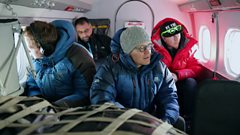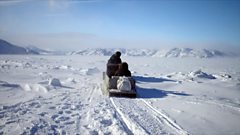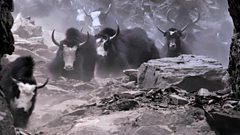Surviving the Extreme
Series looking at places where nature is visible at its most primal, most powerful and most extraordinarily beautiful.
Earth's Natural Wonders are parts of the natural world that nature has carved on such a scale, that they beggar belief - vast mountain ranges, impenetrable rainforests and dazzling tropical islands. Places where nature is visible at its most primal, most powerful, and most extraordinarily beautiful. Survival for human beings can be an incredible challenge.
The Natural Wonders are epic in scale: often rugged, possessing an awe-inspiring beauty. But the factors that create these stunning landscapes, can also present enormous challenges for the people who call them home. The extremes of nature encountered in many of Earth's natural wonders, can threaten human survival, or make human lives extraordinarily demanding. Yet human beings have devised remarkable ways to survive and even thrive in many of these places. Now these Natural Wonders are undergo all sorts of changes, and human survival techniques must also evolve
In the high Himalaya, yak-herder Thokmay Lowa and his small group steer his herd through one of the region's extreme mountain passes. For several months of the year, these herders live isolated lives away from their families, before returning in spring to the summer pastures. Their journey is fraught with hazards, as the terrain they must cross is highly treacherous. With baby yaks being born later than usual this year, some are only a day old when they must tackle the pass.
In the Canadian Arctic, traditional Inuit communities still forage for much of their food. 63-year-old Minnie Nappaaluk and her granddaughter Eva embark on one of the most hazardous expeditions for food - the mussel harvest. Winters here are so extreme the surface of the sea freezes, and when the spring tides go out, the sea ice is suspended above the seabed. Just as Inuit women have done for centuries, Minnie and Eva cut a hole through the sea ice and venture below this shifting, dangerous ice-layer to collect their bounty.
Some Natural Wonders are threatened as never before - nowhere more so than the Brazilian Amazon. In the Mato Grosso, as a result of deforestation, the region's microclimate has changed. Now fires rage out of control in the dry season. Not only do these destroy wild habitats - they also threaten the very existence of the indigenous peoples still living traditional lives in the rainforest. Now, one project aims to tackle these blazes by teaching indigenous peoples how to effectively fight the fires. It's a daunting and dangerous task, but the continuance of their traditional way of life depends upon it.
In the blistering Australian Outback, cattle ranching requires a lot of space. The only way to efficiently round up the herds on these vast farms is through the use of helicopter cowboys like Chris Weyand. It's a dangerous job - he must fly low and slowly over difficult terrain, and every year some pilots are killed. But thanks to the efforts of people like Chris, farming on this scale in the Outback is now possible.
Deep in the Siberian interior, survival is tough. But climate change is opening up a new niche for the human inhabitants of this region - mammoth tusk collection. The tusks have been locked in the Siberian Permafrost for thousands of years, but as the climate changes and the permafrost starts to melt more each summer, it is giving up this unexpected bounty. These tusks are made of ivory, and can sell for thousands of dollars. It is a controversial activity - conservationists argue that it encourages the ivory trade. But for now at least this is a legal pursuit.
Last on
More episodes
Previous
You are at the first episode
Clips
-
![]()
Australia Helicopter Cowboys
Duration: 01:16
-
![]()
Under the Ice
Duration: 01:25
-
![]()
Herding Yaks in Nepal
Duration: 01:31
Music Played
-
![]()
Cliff Richard
Field of Love
Credits
| Role | Contributor |
|---|---|
| Series Producer | Jobim Sampson |
| Director | Russell Leven |
| Executive Producer | Jane Aldous |
Broadcasts
- Wed 14 Feb 2018 21:00
- Sun 25 Feb 2018 16:0591热爆 One except Scotland & Scotland HD
- Sun 25 Feb 2018 17:0591热爆 One Scotland HD & Scotland only
- Thu 8 Mar 2018 08:00
- Thu 6 Sep 2018 23:4591热爆 One except Wales & Wales HD
- Fri 7 Sep 2018 00:1091热爆 One Wales HD & Wales only
- Sun 10 Feb 2019 16:0091热爆 Two except Scotland
- Sat 20 Jun 2020 20:00
- Sun 21 Jun 2020 02:20
- Thu 24 Mar 2022 23:5091热爆 Two Wales & Wales HD only
- Wed 22 Jun 2022 19:00
- Thu 23 Jun 2022 01:30
- Tue 25 Jul 2023 15:4591热爆 Two except Scotland
- Sat 1 Mar 2025 09:4591热爆 Two except Scotland






